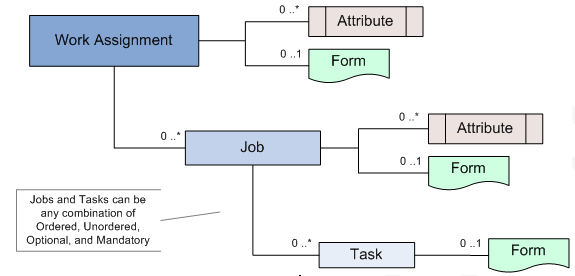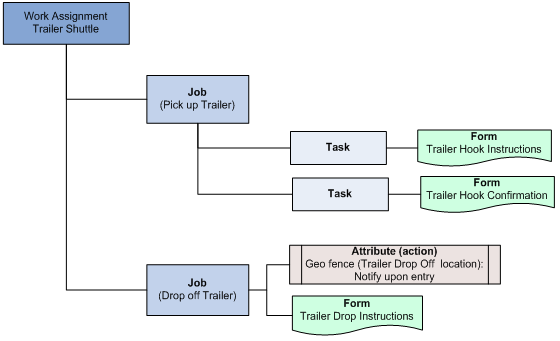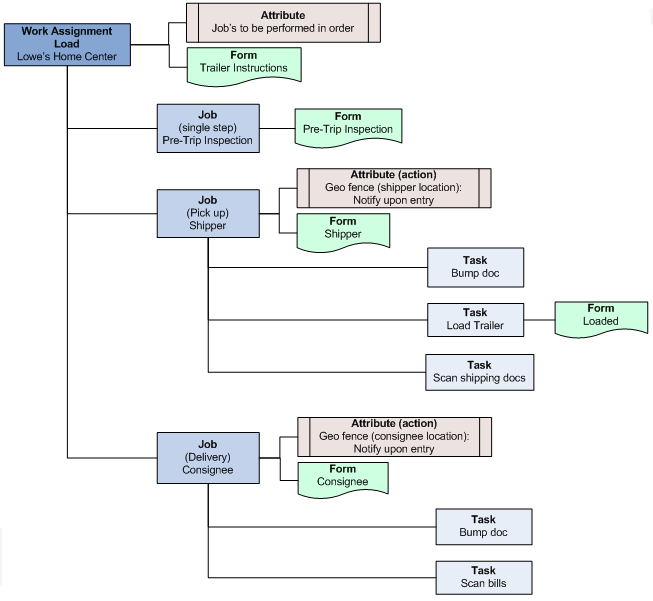Executive Summary
DriverTech’s Fleet Management System provides exceptional flexibility for dispatching work assignments for a truck driver.
- Screen interactions are completely customizable using DriverTech’s proprietary Form Definition Language to create forms.
- A multi-level workflow engine supports hierarchical process-modeling for organizing a driver’s work assignments.
- The system provides access to engine data and driver information which is automatically populated on customized forms that are returned to the customer dispatch system.
- Real-time feedback on job status and the tasks of a work assignment optimize assignments for future work.
- The context-sensitive exception mechanism assists drivers in accurately reporting the reason for a job or task not being completed as planned.
- When a work assignment requires a change, updates can be sent dynamically while preserving the work-assignment state, thus eliminating extra work for a driver.
This work-assignment framework results in increased driver and assignment efficiency. Better visibility into the work-assignment state and post-data analysis can drive improvements in fleet operations.
Presentations
Slide Deck - Workflow Overview and basic features
Video of Workflow Overview - In this presentation we provide an overview of the Workflow Structure, Structure Modifiers (attributes), Geofencing of Jobs, Inclusion of Pre-Populated Inbound Forms and discuss some of the many ways you can leverage workflow in your business
Video ELD Demonstration - In this presentation we perform a Live Demonstration of Workflow on the ELD using SoapUI to send workflows via the Data Service
Video of XSD Review - In this presentation we provide a more in-depth look at the Workflow Structure reviewing the Annotated XSD (available via the Data Service)
Introduction
In the transportation industry, delivering work assignments to drivers is a company’s lifeblood. Work assignments (such as loads, shuttles, training instructions, Truck washes, and so forth), plus the sequence of steps required to complete those assignments, are the foundation for the company’s sustainability and growth. Successfully executed work assignments keep wheels rolling and the bottom line black.
Ideally, the system for processing work assignments should be flexible so changing circumstances can be addressed promptly and efficiently. In reality, that’s not often the case. Work assignments are generally implemented by combining two systems: a customer’s dispatch system and a mobile communication system. Many of these systems are rigid because they rely on fixed constructs.
DriverTech changed the paradigm. Our Fleet Management System provides a unique approach to work assignments that combines the strength of an intelligent communications platform (the TruckPC) with a flexible work-assignment framework. The result is three outstanding benefits:
- Drivers become increasingly efficient at managing their daily assignments.
- Dispatchers can effectively manage a larger number of fleet vehicles.
- The work-assignment framework requires less maintenance.
This white paper shows the logical structure of the DriverTech workflow paradigm, which can be employed with a variety of user interface designs to allow customization at the client level.
Workflow Structure
Work-Assignment
Directing a driver’s daily work is accomplished by sending one or more work assignments, each containing jobs and associated tasks. The definProvitions below provide a context for discussing the process.
- Work Assignment: A single work assignment sent from the customer’s dispatch system.
- Job: A collection of steps a driver follows to complete a work assignment.
For example, pickup and delivery may be defined as the jobs of a load assignment. Watching an instructional video may be defined as a job for a training assignment. - Task: Additional clarification on requirements of a specific job.
To illustrate, a work assignment (load) with a job (pickup) could have a series of instructions on how the pickup is to be done, or on how the delivery is to be accomplished. - Attribute: Additional instructions at any level of the process (work assignment, job, task) on how the work is to be performed.
For instance, an attribute at the work-assignment level might specify that the jobs must be completed in order. An attribute at the job level might provide Geofencing for auto arrival and departure. Attributes vary depending on the nature of the work assignment, job, or task.
Figure 1 shows the relationship of work assignment, job, and task:
Figure 1. Relationship of Work Assignment, Job, Task
Work Assignment Examples
The three diagrams that follow are examples of straightforward work-assignment scenarios, including an assignment for driver training, a trailer shuttle, and a load dispatch.
Driver Training
Figure 2 describes a driver-training assignment where the driver is directed to view a video as part of a periodic training program. After watching the video, the driver is required to take a test.
This work assignment includes a job that explains how the driver is to accomplish the assignment. The attribute initiates a message based on the driver opening the work assignment; the message informs the backend system that the driver has viewed the work assignment. The job form gives the driver instructions on which video to view and presents options for answering test questions.
Figure 2. Driver Work Assignment for training
Trailer Shuttle
The next example, shown in Figure 3, is a trailer-shuttle work assignment. The first job is the pickup phase. The form associated with the job describes which trailer is to be picked up and where it is located. This form provides instructions to the driver and can be automatically populated by the TruckPC with information from the Trailer Tracking system. The second job is the trailer drop off, which includes an attribute that sends a message to the customer system to record that the vehicle has entered the GeoFence. Also included is the trailer drop-off form that is automatically populated with trailer and location information.
Figure 3. Driver Work Assignment for Trailer Shuttle
Load Dispatch
The example in Figure 4 is a sample work assignment for a load dispatch. The driver is to complete three jobs, including a pre-trip inspection, a pickup from the shipper, and a delivery to the consignee. As illustrated, each job can contain tasks that describe in detail what must be accomplished to complete the job. Attributes enhance the system operation by providing audible or visual cues to alert the driver to the proximity of a shipping or delivery location. Finally, forms identify when information needs to be sent to or collected from the driver.
Figure 4. Work Assignment for a Load dispatch
It is easy to see from these figures why flexibility is a highly coveted attribute in dispatching. The following discussion explains how flexibility is integral to DriverTech’s Fleet Management System.
Forms/Templates
The work-assignment process begins with the assumption of a system of record (typically a customer’s dispatch system) that directs the assignments to the work-assignment framework. This leads directly to the most challenging part of the process: the transfer of information, or how information is presented to and collected from the driver.
Most systems use templates for this task. DriverTech takes the concept of templates to a new level. Our Fleet Management System uses a proprietary Form Definition Language (FDL) that allows customers to create custom forms unique to their business. The forms are versatile. They can include informational text fields, numeric or text entry fields, action buttons (with custom labels), dropdown lists, etc. Whatever a customer needs is possible, and easily developed.
There’s more. After the forms are defined, they are automatically downloaded to the TruckPC to be accessed when needed. This means information can be sent from a form, or to a form. The form itself does not need to go over the wires. The sender completes the form’s open fields. The text from those fields is sent to the receiver, but the field descriptions are not. When the receiver pulls up the appropriate form, the fields are automatically populated with the text from the sender. This program feature saves significant money in information transmittal costs.
Forms can also be populated with information provided by the vehicle, driver, TruckPC, or customer’s dispatch system. For example, a form can be populated with an odometer reading, the number of driving hours a driver has left, a truck’s present location, and other data from a variety of sources within the truck.
Driver or Vehicle Exceptions
Exceptions sometimes seem like the rule. Exceptions require assistance when a process step cannot be completed as planned. In the transportation industry, exceptions can apply at any level of the workflow process (i.e., work assignment, job, or task). With rigid systems, exceptions require personal intervention (e.g., a conversation between the dispatcher and the driver). With DriverTech’s Fleet Management System, exceptions can be anticipated and addressed before they occur. The DriverTech work-assignment framework implements a context-sensitive exception mechanism to help drivers select an appropriate exception type based on the work assignment, job, or task in progress.
For example, consider a driver working the pickup job assignment of a shuttle work assignment. The driver cannot find the correct trailer and may need to file an exception for permission to pick up a trailer with a different identification number. Within the context of the job, DriverTech’s exception mechanism presents choices based on that particular, active job. Alternatively, the driver may find the trailer, but during an inspection task discover a mechanical issue (e.g., flat tires, or non-working lights). In this case, the exception mechanism might provide a form for the driver to record the defects found.
Exceptions can be associated with all levels of the process (i.e., work assignment, job, and task).
Initiating a Work Assignment
The framework that makes the process easy to use is also easy to create. Plus, DriverTech’s consultants are available to help throughout the process.
Step 1: Develop a storyboard for the business process. Include all the interaction between backend systems, the truck, and the driver. Define the supporting forms to be used in interacting with the driver.
Step 2: Input the forms into the DriverTech FleetWatcher™ portal. Send the forms to the TruckPC where they can be invoked dynamically.
Step 3: Assemble the work-assignment detail, including jobs, tasks, and form content into an object. Communicate this object to the DriverTech datacenter using a single call to the DriverTech FleetWatcher™ API (web service). After the call, the work-assignment object is resident in the fleet database and subsequently transferred to the truck.
Work assignments can be updated or deleted from the customer dispatch system using the FleetWatcher API™ (web service). All updates and changes to a work assignment are recorded to enable post review and analysis.
Figure 5 shows the communication path between the customer enterprise and the fleet vehicle.
Figure 5 – Communication path from Customer Dispatch System to TruckPC
After the driver invokes the work assignment on the truck, all work-assignment status changes are communicated back from the truck to the datacenter. Changes to work assignments can then be obtained by way of the FleetWatcher™ API (web service).
To complement the dynamic and flexible architecture of the workflow engine, DriverTech has created a rich set of web services to bring the workflow engine to our clients. Web services bridge the gap between disparate systems and avoid complex proprietary interfaces. The DriverTech Fleetwatcher API (web service) provides a simple mechanism to connect applications, regardless of the technology or platform they use, and is ideally suited to interface between different enterprise architectures such as Oracle and SQL.
DriverTech systems have supported workflow engines for the past eight years. The vast experience and understanding we gained during this period have resulted in a rich set of function and feature enhancements. It is important to note that the new capabilities are straightforward extensions of a mature architecture that has been available for a long time. The original implementation was better suited for the private fleet market; the new improvements extend the application for use in other markets, such as truckload and less than load (LTL).




